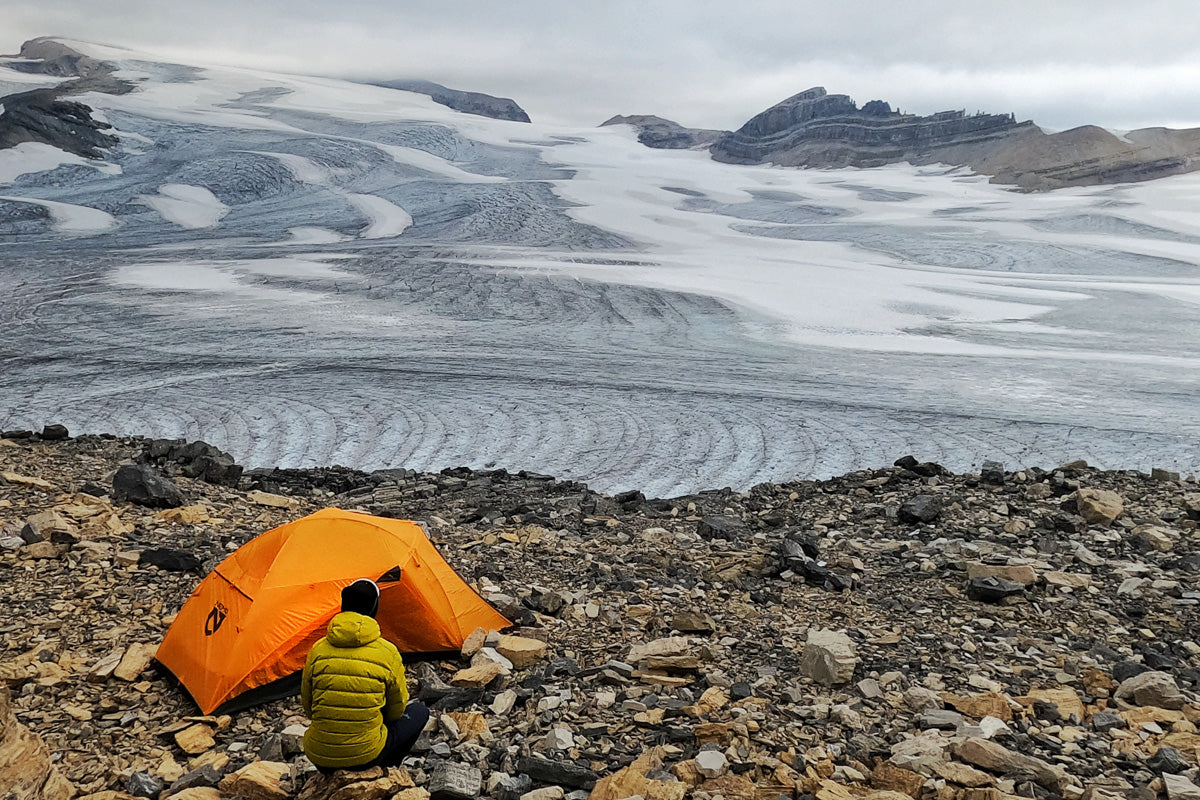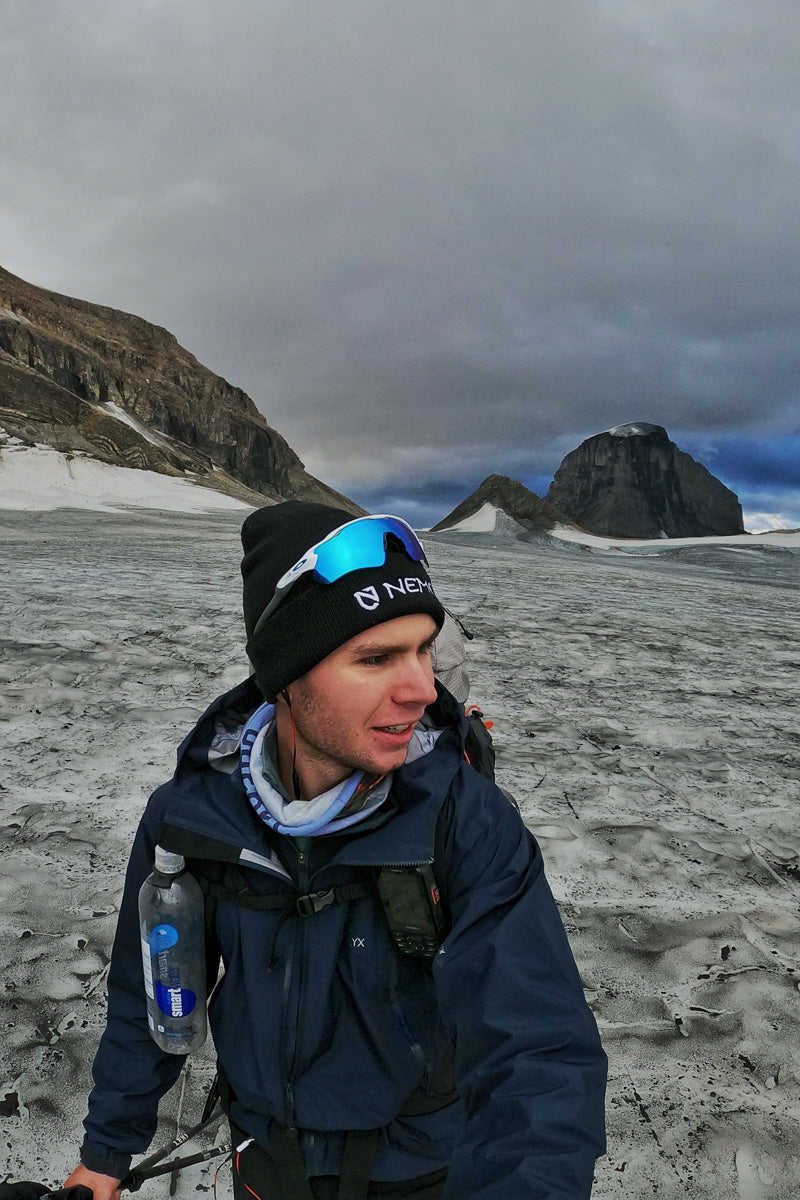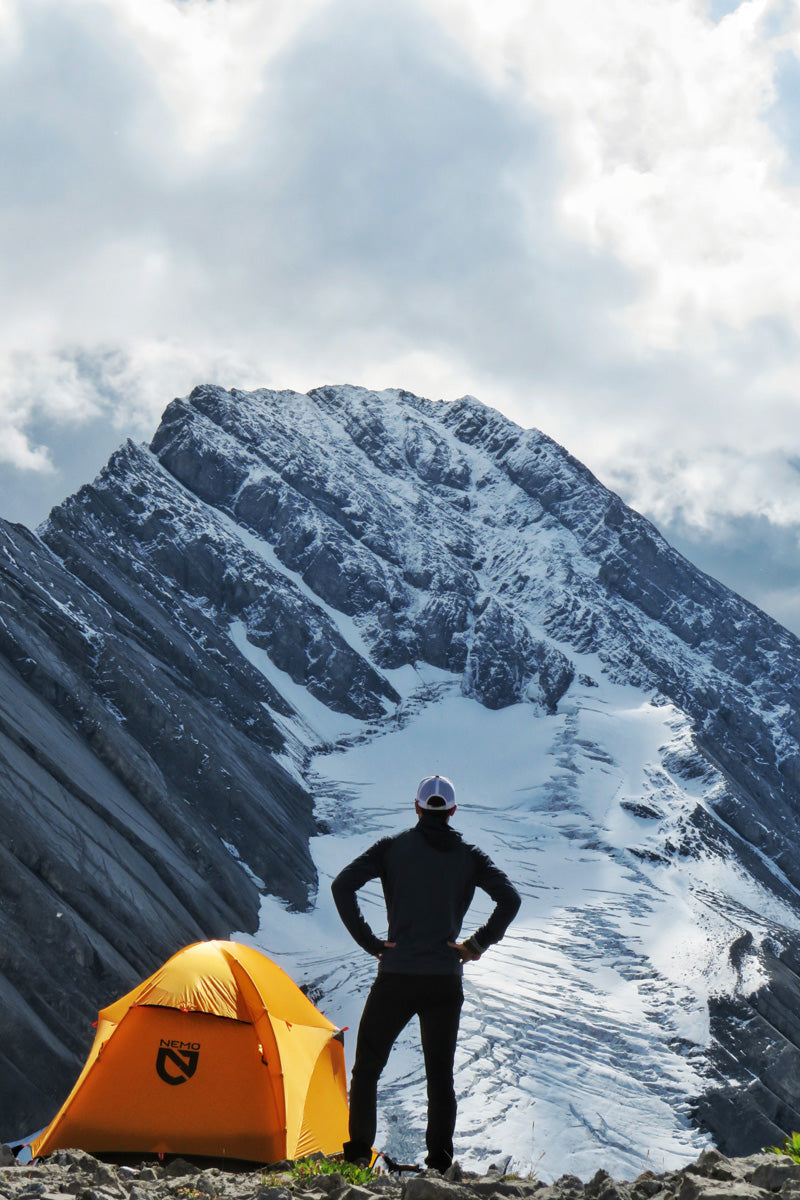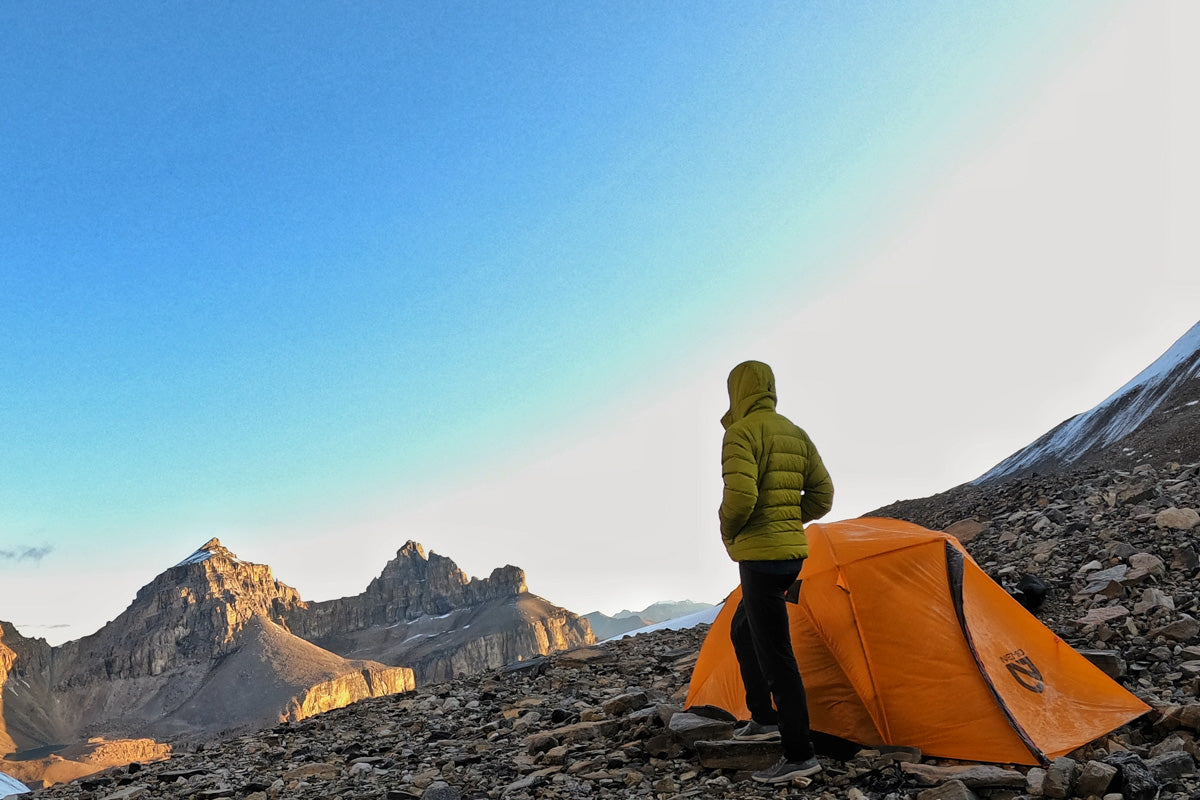
Angels Operation: 34 Days in the Canadian Rockies
The alarm woke me up at 4 a.m. inside my Hornet Elite™ 1P for the 29th consecutive day in the mountains. A thin layer of snow covered the ground down in the valley, which was not a good sign for a safe alpine climb above 11,000 feet. Nevertheless, I packed my rope and ice axes in the dark before leading the way across the last few larches left near 8000 feet. Soon enough, the sun started to warm up the rock on the approach route up Mt. Assiniboine, one of the highest, most striking, and most iconic peaks in the Canadian Rockies.
A grueling battle against harsh conditions and fresh snow made me turn around about halfway up — ultimately heading back to basecamp, packing up, and making the 35km scenic hike out. What a relief when I finally reached the car, a.k.a. my home, right before sunset after an exhausting 12-hour day. The following morning, I woke up again before sunrise to leave with my unpacked backpack for another overnight alpine trip.
And, just like that, I had reached 30 consecutive days alone in the mountains — in this relentless routine that I’d created for this project.
 Sunrise in the Canadian Rockies.
Sunrise in the Canadian Rockies.
WHAT IS ANGELS OPERATION?
I believe the most valuable skill for any mountaineer is to know how to fail successfully, to be able to turn around before it’s too late. Much of the time, objectives need to be called off due to multiple variables, but making those tough decisions is extremely hard emotionally. Therefore, I conceived of a project where each alpine route would most likely be executed under poor conditions, ever-changing weather, or even terrible physical shape. That way, I could learn all about putting emotions aside and develop my decision-making process in those critical and unfavorable situations.
This 5-week, solo, and self-supported journey across wild and remote areas of the Canadian Rockies represented the perfect learning opportunity as an outdoor enthusiast.
 A very memorable bivy site in the backcountry.
A very memorable bivy site in the backcountry.
ANGELS OPERATION IN NUMBERS:
- Days out: 34
- Time spent in the mountains: 160 hours
- Routes targeted: 19
- Routes succeeded: 11
- Elevation gained: 32,654m/20.3 miles
- Distance covered: 549km/321 miles
- Highest point: 3484m/11,427 feet
- Physical exertion: 6/10
- Mental exertion: 10/10
 Gearing up for a technical route.
Gearing up for a technical route.
WEEK 1: BREATHING THROUGH FIRE
I definitely believe it’s official now that we are at a turning point regarding global warming. Once again, wildfires completely ravaged the west coast, leaving the Rockies with a thick layer of smoke that made any outdoor activity a nightmare to keep up. Hopelessness and distress were all I could feel all day, desperately trying to fight against a situation I had no control over.
Needless to say, my body didn’t respond well to the terrible air quality, up to the point where an emergency plan was needed in order to get through it safely.
 Devastating results of the wildfires.
Devastating results of the wildfires.
The first week of this 34-day journey resulted in being entirely unprepared. After a warm-up day, I had to abandon my planned alpine routes temporarily due to all of the thick smoke I inhaled so I could spend time at lower elevations to recover. A heartbreaking decision — but a necessary one considering the circumstances.
Nevertheless, this alternative included some long and technical routes in the mountains as I kept following my golden rule — to just be out there enjoying this beautiful place every single day.
 Technical route during my emergency plan.
Technical route during my emergency plan.
WEEK 2: A BRUTAL COMEBACK
At the end of my 1st week, something magical happened. Heavy rain came in the forecast, the temperatures dropped, and the smoke disappeared. My body could finally work at full capacity, right on time for one of the most remote peaks of the journey. However, I came to understand that smoke wasn’t the only setback in the mountains as I was heading straight into the lion’s den…
 Small break minutes before the storm.
Small break minutes before the storm.
With my Kunai™ 2P staked for the night at 2,900 m, after a grueling GPS-navigated approach, the weather quickly deteriorated into a high-altitude-level storm that pinned me down for 40 hours straight. Some deep frustration began to set in with such a disappointing and scary position, as even getting water became an arduous task.
As a first true failed attempt, I had to constantly remind myself of the project’s primary objective — to act safely in those situations and learn from them.
 Glacier navigating with a storm in the background.
Glacier navigating with a storm in the background.
WEEK 3–4: A TRIP BACK IN TIME
Massive alpine routes often demand a huge amount of thinking and decision-making for a solo climber. And after numerous setbacks, my mind needed quite the motivation boost. Thankfully, I got exactly what I was looking for during the most unexpected day out…
It all started under the crystalline stars during a glacial night surrounded by impressive glaciers and rugged peaks. A slow and inefficient approach lowered my summit chances and ruined my positive mindset. And to top it all off, the recent heatwave turned my ascent route into a very steep and dangerous rockfall zone. But a magnificent sunrise above 3000m was all that was needed for me to keep finding my way up the mountain as the happiest person in the world.
 Rewarded with a sunrise above 3000 m.
Rewarded with a sunrise above 3000 m.
It was because of this very mountain that I discovered mountaineering 10 years ago. When my family and I stepped out of a huge bus on a glacier in the middle of the Rockies, I was completely in awe of the surroundings. We then passed by some climbers and as naïve as a 14-year-old boy could be, I immediately felt that climbing such a mountain was the pinnacle of human achievement.
Ten years later, the roles have changed. I’m now the one who has stood on this massive mountain and was passed by tourists on my way down. This peak has continued to feed my dreams all the way to the climber that I am today.
It's safe to say that this was a very emotional moment for me.
 Reflection at the summit of my own mountain angel.
Reflection at the summit of my own mountain angel.
WEEK 5: ONE LAST PUSH
After a month of nonstop climbing, my body obviously started feeling the heavy load of each step — but it did not stop me from moving forward for one last push. Only 3 multiday alpine routes were planned for this 5th and final week — 3 terrifying summits for my burnt-out body and exhausted mind.
After a disappointing failed attempt on the first mountain and its never-ending approach route, my mind officially shifted out of the game, making it particularly hard to walk straight without the help of poles. “One step at a time, Trist”, I would say as I crawled myself up the 2nd mountain. I set up the bivy lower than what I had planned before tackling, once again, a frightening mountain.
30 days had passed until I realized just how nourishing it is to simply focus on the journey rather than a summit. There are a million things to appreciate down below, you just need to know where to look.
 Contemplating my next summit route.
Contemplating my next summit route.
GEAR LIST
Because of the wide variety of routes planned throughout the adventure, I used 3 different NEMO kits to allow myself the best chances of sleep and recovery while out in the wild.
Ultralight Kit
- Shelter: Hornet Elite™ 1P
- Sleeping bag: Kayu™ 15° Down Mummy
- Sleeping pad: Tensor™ Regular
Well tested over the past few years, this kit is my go-to setup for any alpine overnight adventure where every ounce matters. In opposition to most UL setups out there, the Hornet Elite™ has the perfect ratio between weight and volume while being stronger than most against the elements. Many more adventures to come with this flawless sleeping system!
 A designated campground — it felt like a hotel!
A designated campground — it felt like a hotel!
Luxury Kit
- Shelter: Kunai™ 2P 3-4 Season Backpacking
- Sleeping bag: Riff™ 15° Spoon™ Shape Down
- Sleeping pad: Quasar™ Insulated Wide
New for this project, this setup turned out to be the most useful one given the areas I explored. Multiday ascents where basecamp remains the same location for 24+ hours are usually the ideal situation for this setup as it is carried in and out only once. This kit allowed for more protection and comfort during this trip — especially when heavy storms rolled in at night.
 A crisp morning in the freezing temperatures of the Canadian Rockies.
A crisp morning in the freezing temperatures of the Canadian Rockies.
Mixed Kit
- Shelter: Kunai ™ 2P 3-4 Season Backpacking
- Sleeping bag: Kayu™ 15° Down Mummy
- Sleeping pads: Tensor™ Regular + Switchback™
If you’ve ever had this dilemma between weight and protection, this mixed setup has been my own personal solution. I get the bombproof features from the Kunai™ mountaineering tent while still cutting off some significant weight with ultralight bags and pads. That way, I can adventure on long and technical routes and still be stress-free for the nights to come.
 Visualizing my next climbing route.
Visualizing my next climbing route.
A TRAINING in HUMILITY
It might sound incoherent to purposely put myself in unsafe environments, to seek misery in such wild places. Expeditions are usually only prepared and executed when all the variables are aligned to reach the highest success rate. But this year, I wanted to pursue different paths and to learn the most valuable lessons in the backcountry to become a more skilled mountaineer for the bigger projects to come.
 Snow in August, casual in the Canadian Rockies!
Snow in August, casual in the Canadian Rockies!
Angels Operation has been a game-changer for me as an endurance athlete and an excellent way for me to take a step back and genuinely appreciate how I’ve dealt with each situation despite how incredibly laborious they all have been.
I needed to hit some walls, to cry my eyes out in the middle of nowhere, to face my deepest fears, and to experience disappointment. It is extremely hard emotionally, but also somehow nourishing. I shed many tears out there, that’s for sure.
 Mount Assiniboine at sunset.
Mount Assiniboine at sunset.
No matter what goal you are pursuing, it will never be as exceptional as the journey.
Take the time to look around you and cherish the experience. Never forget the reason why you are out there in the first place as it often comes from your heart, the purest place of all.
 The most beautiful bivy site I’ve ever been.
The most beautiful bivy site I’ve ever been.
Tristan Hogue is a mountain enthusiast, student, and trail runner based in Montreal. He hopes to inspire others to live their dreams by exposing himself to unique and challenging projects around the world and passing on his wealth of training techniques and practices. Follow him on Instagram at @trist.hogue.
